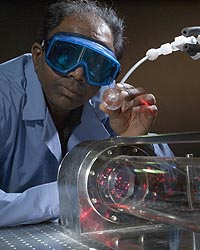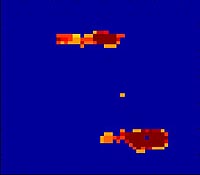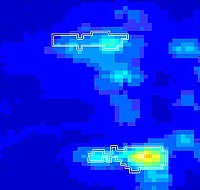Highlights
New sensor technology detects chemical, biological, nuclear and explosive materials
Applications for homeland security, emergency planning

PPB DETECTION – Instruments in Argonne's Terahertz Test Facility, such as the one Sami Gopalsami
is using, can detect trace chemicals at the part-per-billion level. Click on photo to view a larger image.
Download image
from Flickr
ARGONNE, Ill. (March 21, 2006) — Engineers at the U.S. Department of Energy's Argonne National Laboratory, using an emerging sensing technology, have developed a suite of sensors for national security applications that can quickly and effectively detect chemical, biological, nuclear and explosive materials.
"We can use this technology to detect chemical and biological agents and also to determine if a country is using its nuclear reactors to produce material for nuclear weapons or to track the direction of a chemical or radioactive plume to evacuate an area," explained Paul Raptis, section manager. Raptis is developing these sensors with Argonne engineers Sami Gopalsami, Sasan Bakhtiari and Hual-Te Chien.
Argonne engineers have successfully performed the first-ever remote detection of chemicals and identification of unique explosives spectra using a spectroscopic technique that uses the properties of the millimeter/terahertz frequencies between microwave and infrared on the electromagnetic spectrum. The researchers used this technique to detect spectral "fingerprints" that uniquely identify explosives and chemicals.


MM-WAVE RADAR – Millimeter-wave radar images taken 9 km from a nuclear power plant can detect when the plant is operating (upper image) or idling (lower image).
The Argonne-developed technology was demonstrated in tests that accomplished three important goals:
- Detected and measured poison gas precursors 60 meters away in the Nevada Test Site to an accuracy of 10 parts per million using active sensing.
- Identified chemicals related to defense applications, including nuclear weapons, from 600 meters away using passive sensing at the Nevada Test Site.
- Built a system to identify the spectral fingerprints of trace levels of explosives, including DNT, TNT, PETN, RDX and plastics explosives semtex and C-4.
Current research involves collecting a database of explosive "fingerprints" and, working with partners Sarnoff Corp., Dartmouth College and Sandia National Laboratory, testing a mail- or cargo-screening system for trace explosives.
Argonne engineers have been exploring this emerging field for more than a decade to create remote technology to detect facilities that may be violating nonproliferation agreements by creating materials for nuclear weapons or making nerve agents.
How it works
The millimeter/terahertz technology detects the energy levels of a molecule as it rotates. The frequency distribution of this energy provides a unique and reproducible spectral pattern – its "fingerprint" – that identifies the material. The technology can also be used in its imaging modality – ranging from concealed weapons to medical applications such as tumor detection.
The technique is an improvement over laser or optical sensing, which can be perturbed by atmospheric conditions, or X-rays, which can cause damage by ionization. Operating at frequencies between 0.1 and 10 terahertz, the sensitivity is four to five orders of magnitude higher and imaging resolution is 100 to 300 times more than possible at microwave frequencies.
Other homeland security sensors
To remotely detect radiation from nuclear accidents or reactor operations, Argonne researchers are testing millimeter-wave radars and developing models to detect and interpret radiation-induced effects in air that cause radar reflection and scattering. Preliminary results of tests, in collaboration with AOZT Finn-Trade of St. Peterspurg, Russia, with instruments located 9 km from a nuclear power plant showed clear differences between when the plant was operating and when it was idling. This technology can also be applied to mapping plumes from nuclear radiation releases.
Argonne engineers have also applied this radar technology for remote and rapid imaging of gas leaks from natural gas pipelines. The technique detects the fluctuations in the index-of-refraction caused by leaking gas into surrounding air.
Early warnings of biological hazards can be made using another Argonne-developed sensing system that measures dielectric signatures. The systems sense repeatable dielectric response patterns from a number of biomolecules. The method holds potential for a fast first screening of chemical or biological agents in gases, powders or aerosols.
Other tests can detect these agents, but may take four hours or longer. "While this method may not be as precise as other methods, such as bioassays and biochips, it can be an early warning to start other tests sooner," said Raptis.
These Argonne sensor specialists will continue to probe the basics of sensor technology and continue to develop devices that protect the nation's security interests.
Other potential applications for these technologies, in addition to security, include nondestructive evaluation of parts, environmental monitoring and health, including testing human tissue and replacing dental X-rays.
In addition to DOE, the U.S. Department of Defense and the National Aeronautics and Space Administration have provided support for this research.
[ More News ]
Last Modified: Wed, April 20, 2016 9:33 AM


